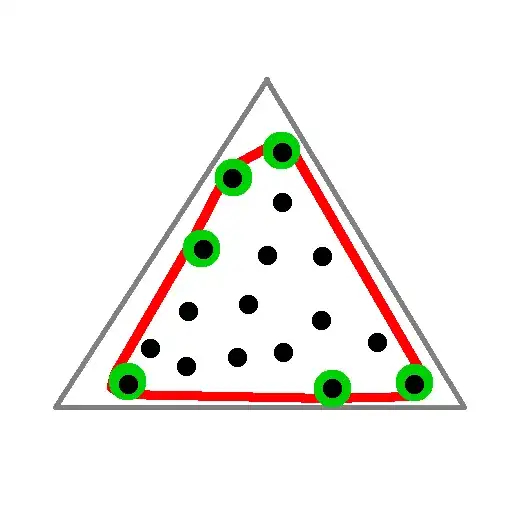For triangle, $E_n = 2H_{n-1}$ where $H_{n-1} = \sum\limits_{k=1}^{n-1} \frac{1}{k}$ is the $(n-1)^{th}$ Harmonic number.
In general, if you sample $n$ points $x_1, \ldots, x_n$ uniformly from a convex body $K$ of unit area and look at their convex hull $C_n = \mathrm{co}(x_1,\ldots,x_n)$. We have the relation
$$\Delta_{n-1} = 1 - \frac{E_n}{n}$$
where $E_n$ is the expected number of vertices for $C_n$ and $\Delta_{n-1}$ is the expected area of $C_{n-1} = \mathrm{co}(x_1,\ldots,x_{n-1})$.
We can understand this relation like this. $E_n$ is $n$ times the probability
that $x_n$ is a vertex of $C_n$. Since the probability that $x_n$ lies on the edge
of $C_{n-1}$ is zero, the probability that $x_n$ is a vertex of $C_n$ is the same as the probability that $x_n \not\in C_{n-1}$ which in turn equals to $1 - \Delta_{n-1}$.
When $K$ is a triangle, according to
this article on mathworld,
$$\Delta_n = 1 - \frac{2H_{n}}{n+1}$$
This means the expected number of vertices you seek is $E_n = 2 H_{n-1}$.
Update
For completeness and documentation purposes, let me outline how to compute $\Delta_n$ and hence $E_n$ ourselves.
Define $\rho$ such that $\frac{1}{\rho^2} = \frac{\sqrt{3}}{4}$, the area of an equilateral triangle of side length $1$. We will take $K$ to be the equilateral triangle with vertices at $(0,0)$ and $(\rho\cos\frac{\pi}{6},\pm \rho\sin\frac{\pi}{6})$.
For any $\theta \in [0,2\pi]$ and $p \in \mathbb{R}$, let
- $\ell(\theta,p)$ be the line $\{ (x,y) : \cos\theta x + \sin\theta y = p \}$.
- $L(\theta,p)$ be the length of the line segment $\ell(\theta,p) \cap K$.
- $H(\theta,p)$ be the half-space $\{ (x,y) : \cos\theta x + \sin\theta y \le p \}$.
- $A(\theta,p)$ be the area of $H(\theta,p) \cap K$.
For any $\lambda \in [0,1]$, choose a $p$ so that $A(\theta,p) = \lambda$.
Let $m(\theta,\lambda) = L(\theta,p)^2$ for this particular $p$.
Repeating arguments in this answer and using symmetry, $\Delta_n$ has following integral representation:
$$
\Delta_n =
1 - \frac{n}{6}\int_0^{2\pi} \int_0^1 \lambda^{n-1} m(\lambda,\theta) d\lambda
= 1 - n \int_0^{\pi/3} \int_0^1 \lambda^{n-1} m(\lambda,\theta) d\lambda
$$
For any $\lambda \in [0,\frac{\pi}{3}]$, let
$\tau = \frac{
\cos\left(\theta + \frac{\pi}{6}\right)}{
\cos\left(\theta - \frac{\pi}{6}\right)}
$, one can check that
$$m(\lambda,\theta ) = \frac{4}{\rho^2\cos^2\left(\theta-\frac{\pi}{6}\right)}
\times \begin{cases}
\frac{\lambda}{\tau},& \lambda \in [0,\tau]\\
\frac{1-\lambda}{1-\tau},& \lambda \in [\tau, 1 ]
\end{cases}
\quad\text{ and }\quad
\frac{4 d\theta}{\rho^2\cos^2\left(\theta-\frac{\pi}{6}\right)} = 2d\tau
$$
Integrate first over $\lambda$ and then over $\tau$, we obtain:
$$\Delta_n =
1 - 2n\int_0^1 \int_0^1 \lambda^{n-1} m(\lambda,\theta) d\lambda d\tau
= 1 - \frac{2}{n+1}\int_0^1 \frac{1-\tau^n}{1-\tau} d\tau = 1 - \frac{2H_n}{n+1}$$
